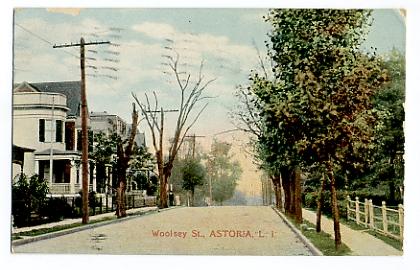Astoria History
In the recently published Queens Tribune's "The Queens Story", reporter Liz Goff tells us in her wonderfully written and presented "Settling Queens" that "Dutch explorer/trader Adriaen Block became the first white man to view Astoria in 1614, when he became the first person to navigate Hell's Gate, through the East River and into the Long Island sound". Thus starts the history of that portion of Queens we now know as Astoria.

Woolsey Street - Astoria 1911
Astoria is the neighborhood in northwestern Queens (pop. approx. 225,000), constituting the part of Long Island City north of Broadway, east of the East River, west of roughly 51st Street and south of the Long Island Sound. There may be as many geographic descriptions of Astoria as there are residents. It was developed from 1839 by Stephen A. Halsey, a fur merchant who petitioned the state legislature to name it for the prominent fur trader John Jacob Astor, in an unsuccessful effort to have Astor become a financial patron of the area. During the 1840s and 1850s it grew slowly inland from the ferry landing at the foot of Astoria Boulevard (where an early settlement was known as Hallett's Cove). Wealthy New Yorkers built mansions on 12th and 14th streets and on 27th Avenue. The German United Cabinet Workers brought four farms in 1869 between 35th and 50th streets and developed a German town. In the following year Schuetzen Park was laid out at Broadway and Steinway Street (this remained a landmark for half a century) and a large trace on both sides of Steinway Street from Astoria Boulevard to the East River was bought by the piano maker William Steinway, who set up factories along the shore and a village to their south. On May 4, 1870, Astoria, Hunter's Point, Steinway and Ravenswood consolidated to form Long Island City. Treacherous reefs in Hell's Gate were dynamited in 1876 and 1885 at the behest of the federal government. Thousands of houses were built during the 1890s and the early twentieth century. The shore of the East River became a park in 1913, and the first rapid transit line, the Astoria elevated, opened on 31st Street on February 1, 1917. Many six family apartment buildings and housing projects were added during the 1920s and 1930s.
Motion picture studios were opened in 1920 by the Famous Players - Lasky Corporation at 35th Avenue between 34th and 37th streets in Astoria, just across the East River from the company's headquarters in Manhattan. Between 1921 and the time the company became known as Paramount in 1927, about one quarter of its films were made there (the rest were made in Hollywood). Adapted for the production of motion pictures with sound by Western Electric in 1929, the facility was renamed Eastern Studios, Inc. The proximity of the studio to Broadway was of benefit to Paramount, which produced such films there as the musical Heads Up (1930), by Richard Rodgers and Lorenz Hart. The production of feature films diminished during the mid 1930s and virtually ceased by 1937, though the studio continued to be used for short subjects, "second unit" work for films made in Hollywood, and Paramount News. In 1942, the U.S. Army took control of the studio, which it renamed the Signal Corps Photographic Center, and began producing and editing wartime films (A World at War, 1943; Autobiography of a Jeep, 1943); the army continued to use the studio to produce educational and training films until the 1960s. In 1975, the studio reopened for the production of commercial feature films: among the many films made there in the following years were Sidney Lumet's The Wiz (1977), Bob Fosse's All That Jazz (1979), and Woody Allen's Radio Days (1987). In 1988, the studio became the site of the Museum of the Moving Image, while continuing its commercial operations. One of the buildings in the area now houses the Museum of the Moving Image.
The Independent subway extended service along Steinway Street and Broadway on August 19, 1933, and new connections to Manhattan and the Bronx were provided by the Triborough Bridge, which opened on July 11, 1936.
After the Second World War Astoria was largely Italian. Greek residents rapidly increased in number after 1965: one third of all Greeks who moved to New York City in the 1980s settled in the neighborhood, and by the mid 1990s they accounted for slightly less than half its population. St. Demetrious, one of the eleven Greek Orthodox churches in the area, is probably the largest Orthodox church outside Greece. Greek immigrants who settled in the neighborhood received aid from the Hellenic Americans Neighborhood Action Committee, a locally based social services agency. Other ethnic groups also established communities in the area, including Colombians, Chinese, Guyanese, and Koreans, and to a lesser extent Ecuadorians, Romanians, Indians, Filipinos, and Dominicans.
Today, Astoria is one of the most vibrant, mixed, colorful and interesting of the many neighborhoods which comprise New York City. As befitting such an energetic community, it continues to grow and develop and has yet to reach its full potential. The 21st Century will be an exciting time in Astoria. Stay tuned!